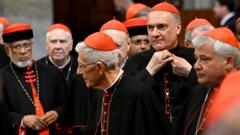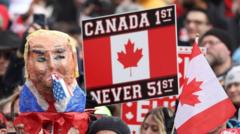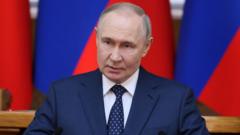With the election pivotal for Canada’s future, the electorate must navigate issues of sovereignty, economic stability, and leadership character in a fraught atmosphere marked by President Trump's interferences.
Canada's Pivotal Election: Trump, Trade, and the Race for Leadership

Canada's Pivotal Election: Trump, Trade, and the Race for Leadership
As Canadians head to the polls on April 28, the choice between Conservative Pierre Poilievre and Liberal Mark Carney exemplifies their response to international pressures and internal economic concerns.
Canadians cast their votes today in a critical election that stands to significantly shape the nation’s political landscape, especially against the backdrop of President Trump's ongoing trade tensions and controversial assertions about sovereignty.
Opinion polls before the election indicated that the Liberal Party, led by freshly appointed Prime Minister Mark Carney, edged out the Conservative Party under Pierre Poilievre—once the clear frontrunner. Just three months ago, the Conservatives held a dominating 25-point lead. Now, a combination of Trump’s tariff threats and Carney’s ascent has turned the tide in favor of the Liberals.
As Canadians make their selections for parliamentary representatives, they face multiple parties at play: in addition to the Liberals and Conservatives, the New Democratic Party, the Green Party, and Bloc Quebecois are also contesting. The election continues the trend of political upheaval following Trudeau's resignation in March, with Carney's leadership promising a stabilizing focus against the U.S. President's threats.
The dynamics of this election reflect not only personal leadership styles—Carney, a centrist technocrat with a wealth of financial experience, and Poilievre, a populist politician with strong ties to Trump—but also reflect broader issues that resonate with Canadians: inflation concerns, their responses to U.S. trade policies, and their national identity amidst foreign pressures.
Polling stations vary across Canada, ensuring ample opportunity for voters to make their voices heard with extended voting hours factored by time zone. With 343 parliamentary seats at stake, including crucial urban districts in the populous Greater Toronto Area, strategists predict that any shift in voter sentiment could tip the election either way.
In light of Trump’s brazen call for Canadians to consider aligning themselves with the U.S. as the "51st state," Poilievre has publicly urged the president to refrain from interfering in Canadian politics, asserting Canadian sovereignty must prevail. Conversely, Carney's campaign brandishes an anti-Trump stance aimed at reassuring voters of his capability to navigate the challenges posed by a volatile U.S. administration.
As ballot counting progresses shortly after polls close, the results will determine the next chapter for Canada. Expect results throughout the evening, with emerging dynamics shaping future conversations both within the country and with the international community.
Opinion polls before the election indicated that the Liberal Party, led by freshly appointed Prime Minister Mark Carney, edged out the Conservative Party under Pierre Poilievre—once the clear frontrunner. Just three months ago, the Conservatives held a dominating 25-point lead. Now, a combination of Trump’s tariff threats and Carney’s ascent has turned the tide in favor of the Liberals.
As Canadians make their selections for parliamentary representatives, they face multiple parties at play: in addition to the Liberals and Conservatives, the New Democratic Party, the Green Party, and Bloc Quebecois are also contesting. The election continues the trend of political upheaval following Trudeau's resignation in March, with Carney's leadership promising a stabilizing focus against the U.S. President's threats.
The dynamics of this election reflect not only personal leadership styles—Carney, a centrist technocrat with a wealth of financial experience, and Poilievre, a populist politician with strong ties to Trump—but also reflect broader issues that resonate with Canadians: inflation concerns, their responses to U.S. trade policies, and their national identity amidst foreign pressures.
Polling stations vary across Canada, ensuring ample opportunity for voters to make their voices heard with extended voting hours factored by time zone. With 343 parliamentary seats at stake, including crucial urban districts in the populous Greater Toronto Area, strategists predict that any shift in voter sentiment could tip the election either way.
In light of Trump’s brazen call for Canadians to consider aligning themselves with the U.S. as the "51st state," Poilievre has publicly urged the president to refrain from interfering in Canadian politics, asserting Canadian sovereignty must prevail. Conversely, Carney's campaign brandishes an anti-Trump stance aimed at reassuring voters of his capability to navigate the challenges posed by a volatile U.S. administration.
As ballot counting progresses shortly after polls close, the results will determine the next chapter for Canada. Expect results throughout the evening, with emerging dynamics shaping future conversations both within the country and with the international community.






















